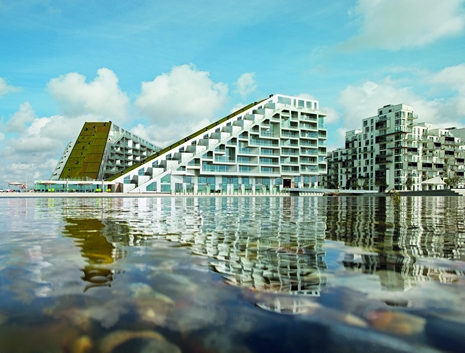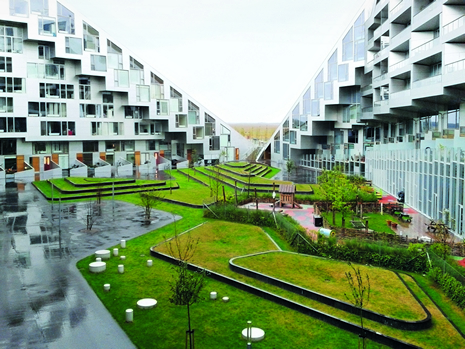Description
This project description is an excerpt from the longer article “Big Buildings”. For a comparative analysis and further data on this and all other categories including accompanying graphs, please see the article “A Turning Point”.
An iconic submultiple that represents an experiment in generating diversity of unit types taken to a whole other level is the 8 Tallet project by Bjarke Ingels Group (BIG) completed in 2010. Unlike the brownfield redevelopments undertaken in the two examples above, this project was constructed on a greenfield site in Ørestad, a new five-kilometer strip of development in southern Copenhagen between the historic city and the Kalvebod Fælled (Common) nature reserve. Just 10 minutes to the city center by metro, Ørestad was planned as Copenhagen’s ‘sixth finger’ of urban growth in 1994, and is expected to accommodate 20,000 residents and 60,000 to 80,000 employees by the time it is completely built out.
[1]
[2]
In 2006, St. Frederikslund Holding and Høpfner Projects Ltd commissioned the BIG team to design what was then Denmark’s largest private residential development at the very edge of the nature reserve. In particular, this was a collaboration initiated by Per Høpfner who had already formed a working partnership with Bjarke Ingels dating back to two earlier projects also in the Ørestad – the V & M Houses, and the Mountain House – which were designed by PLOT before Ingels and Julien De Smedt parted ways. As at The Whale, the BIG team started with a 10-storey, 230 meters by 110 meters perimeter block. Rather than adhering to the conventional Danish treatment where the variation on the façade is produced as a serial permutation of different waterfront row houses, the team decided instead to stack the functions: they began with a commercial base, followed by a layer of row houses as a modern interpretation of the traditional
From Ingels’ perspective, 8 Tallet was designed to be a “three-dimensional neighborhood rather than an architectural object… [w]here social life, the spontaneous encounter, and neighbor interaction traditionally… restricted to the ground level” is allowed to “expand all the way to the top”.
3
Bjarke Ingels, cited in “Copenhagen’s BIG Architects Complete 8 House Landmark Residential Project,” by Alma Kadragic, World Property Channel, accessed November 2, 2013, http://www.worldpropertychannel.com/featured-columnists/uae-watch-big-bjarke-ingels-group-8-house-guinness-book-of-records-emaar-burj-khalifa-stfredeikslung-holding-per-hopfner-hopfner-partners-3367.php
This ‘three-dimensional’ character of the project takes its form in two key spatial operations: first, the strata of some 150
4
Bjarke Ingels, cited in “8 House, Village Gigantesque = 8 House, A Giant Village,” by Marie-Douce Albert, Architecture d’Aujourd’hui 380 (November–December 2010): 155.
Area-wise, these units range from 58 square meters to 175 square meters, all of which are relatively commodious in their space provisions. Besides this exceptional degree of diversity, 8 Tallet was also successful in creating a dense live-work environment, attaining a residential density of 188 dwelling units per hectare.
Footnotes
“Facts on Ørestad,” Ørestad, accessed November 2, 2013, http://www.orestad.dk/Fakta.aspx
1994 Competition Stipulation cited in “Copenhagen Growing: The Story of Ørestad,” Ørestad, accessed November 2, 2013, http://www.orestad.dk/Fakta/~/media/Orestadhttps://bdt.degruyter.com/cdn/wp-content/uploads/dgimport/pdf/Copenhagen-Growing_web.ashx
Bjarke Ingels, cited in “Copenhagen’s BIG Architects Complete 8 House Landmark Residential Project,” by Alma Kadragic, World Property Channel, accessed November 2, 2013, http://www.worldpropertychannel.com/featured-columnists/uae-watch-big-bjarke-ingels-group-8-house-guinness-book-of-records-emaar-burj-khalifa-stfredeikslung-holding-per-hopfner-hopfner-partners-3367.php
Bjarke Ingels, cited in “8 House, Village Gigantesque = 8 House, A Giant Village,” by Marie-Douce Albert, Architecture d’Aujourd’hui 380 (November–December 2010): 155.
Drawings
Axonometric site plan of building and its surroundings
Sectional perspective of building within its specific urban context
Site plan, scale 1:20000
Site plan illustrating the building’s contextual connectivity
Standard townhouse floor plan, scale 1:750
Standard apartment floor plan, scale 1:750
Section, scale 1:1500
Axonometric and sectional usage distribution diagrams
Residential unit types and distribution, scale 1:500
Photos

Exterior view

View of courtyard
Originally published in: Peter G. Rowe, Har Ye Kan, Urban Intensities: Contemporary Housing Types and Territories, Birkhäuser, 2014.